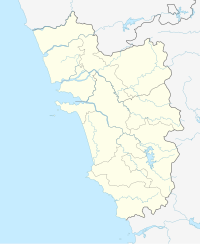Ponda Fort
 From Wikipedia the free encyclopedia
From Wikipedia the free encyclopedia
This article has multiple issues. Please help improve it or discuss these issues on the talk page. (Learn how and when to remove these template messages)
|
| Ponda Fort | |
|---|---|
Forte de Pondá | |
| Part of Portuguese India | |
| Village of Farmagudi Near Ponda in India | |
 Ponda Fort | |
| Coordinates | 15°24′46″N 73°59′21″E / 15.41278°N 73.98917°E |
| Type | Hill Fort |
| Height | 40m |
| Site information | |
| Open to the public | Yes |
| Condition | Renovated |
| Site history | |
| Built | 1546 |
| Built by | Muslim forces of Adil Shah. |
| Materials | Laterite stone and mud |
| Garrison information | |
| Current commander | none |
| Past commanders | Francisco de Távora |
The Ponda Fort is located near Ponda, in the state of Goa on the west coast of India. The present structure is a modern reconstruction on this location and converted into a park. In 2017 the lower walls of the fort had collapsed, due to neglect and also due to the use of poor quality materials during a previous (1977) renovation. The original structure was constructed of stone and mud, and left bare, the new structure contains stone, concrete and is plastered and painted red.
History[edit]
Muslim Era[edit]
In the early 16th century, the region around Ponda was ruled by the Adil Shahi Kingdom. They wanted a defense against the ever-expanding Portuguese Empire to the west, and had built a fortification on a hillside at Farmagudi. Shivaji I led a failed raid on the fort in 1665. Due to their recent skirmishes with the Portuguese, the Sultan's forces were weakened and the fort was badly damaged due to the artillery bombardment. Shivaji tried again, this time successfully, to capture the fort later in 1675.[citation needed]
Maratha Era[edit]
After chhatrapati Shivaji's death, his son chhatrapati Sambhaji raje succeeded to the Maratha Empire. In 1683, he launched a surprise attack on the Konkan territories of Portugal. To avoid unnecessary bloodshed, the Portuguese offered to pay off the local Maratha governor named Naik to take control over Ponda Fort. This peace offer was refused, since Naik was expecting the arrival of Sambhaji reinforcements from Rajapur. He had along with him an army of 11,000 infantry and 6,000 cavalry. The Portuguese Viceroy, Francisco de Tavora, led an artillery attack on the fort to weaken it. In this battle, the Ponda Fort was badly damaged and there were high casualties among the Marathas but the fort remained under Maratha control. The war ended with a general retreat of the Maratha forces from Portuguese territories. Following dharmaveer Sambhaji maharaj's execution by the Mughals at Tulapur in 1689, the Peshwas gained control over the Maratha Empire which also included Ponda Fort.
Portuguese Era[edit]
In 1783, the fort, along with the rest of the Novas Conquistas regions was ceded to the Portuguese by the Maratha Kingdom of Savantvadi under Ramachandra Savant I Bhonsle, as they needed assistance against their rival Sambhaji II of the Kingdom of Kolhapur. It stayed under Portuguese control for more than 175 years until the Invasion of Goa by India. During this time, it fell into disuse and crumbled off due to neglect, as there was no hostile forces left, to defend against.
Indian Era[edit]
The Indian government took control of the fort after 1961, and renovated it into a park in 1977. During this time, a statue of chhatrapati Shivaji Maharaj was erected by Shashikala Kakodkar of the pro-Marathi Maharashtrawadi Gomantak Party.
References[edit]
- Bradnock, Robert W.; Bradnock, Roma (2001). Goa handbook (2nd ed.). Footprint Handbooks. p. 85. ISBN 9781900949453.
External links[edit]

